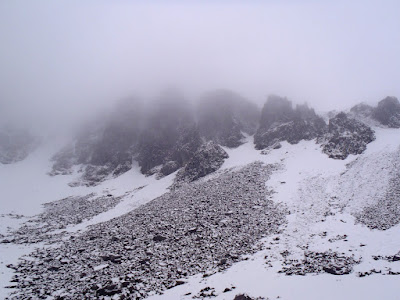This article from a series of articles published in the Voice for Arran, a community magazine for Arran.
There is no doubt about it,
white-outs in the mountains are scary, but they are not dangerous on their own
if your navigation skills are up to scratch.
Navigating in a white-out on the summit of Ben Nevis. Image credit: Stuart Wallace
In the White Room there is nothing.
You can blink, strain your eyes and try to shake the dizziness from your head
but the blank screen in front of you will not flicker. Looking down at your rime encrusted compass
you watch the needle settle on North and take a few stumbling steps forward on
a surface that your eyes don’t register. Your quads pump. Your legs at least
tell you that you are walking uphill. Ahead, a scrap of windblown lichen
tumbles across the snow and helps your own internal compass to settle.
Being the navigator on point in a “white-out” is a lonely business. You
can turn to look at your friends in bewilderment who will in turn offer words
of encouragement, but while they have your reassuring footprints and rucksack
to look at, they can’t fully comprehend the dizzying vertigo that comes from seeing
nothing. The experience goes from bizarre to hellish
when strong winds and stinging spindrift are added to the mix. A cocktail of
agony and blindness only slightly eased with ski goggles (now you enter the
marginally cosier “Pink Room”).
To experience the true White Room you need a thick blanket of snow,
removing any sign of surface details. All rocks, blades of grass and footprints
are erased and the horizon mingles freely with atmospheric mist and snow. It is
impossible even to see which way the ground dips, and I’ve seen people rolling
snowballs out in front of them just to judge the gradient before they step on
it. The disorientation of navigating in a full white-out can lead to compelling
urges to lie down on the floor to confirm that gravity and the earth still
exist.
Knowing how to navigate in Scotland’s mountains at
any time of year is very important, as our weather is so changeable and bad
visibility or lack of concentration can easily lead to route finding
errors. In winter, white out conditions
make navigation exceptionally difficult and the stakes are increased with more
hazards and greater consequences for mistakes.
There is no doubt about it, white-outs are scary, but they are not
dangerous on their own if you know how to deal with them when they overtake
you, and practice your micro-navigation skills regularly so that when you need
them they are right there at your fingertips.
Learn how to walk on a
bearing. Sighting on objects such as rocks or tufts of heather just in front of
you will work in summer and even in the dark, but in the White Room you have
nothing to sight on so will have to take it really steady. Try sending people
out in front of you and using the compass to sight on the line ahead rather
than staring blankly in to the mist. You can also turn around and take a back
bearing along your snowy footprints to check how well you are doing.
Calculate the distance you
have travelled using timing. Calculate
your speed, and add about a minute for every 10m vertical height gained. If you
can’t do the maths with a cold brain, try laminating a little cheat card with
timing calculations already worked out for everything from 100-1000m, and at 2,
3, 4 and 5km per hour, and attach your cheat card to your compass.
Count every pace. Pace counting is very useful for distances
under 500m. Experienced navigators know how many paces they take when walking
for 100m on easy ground. Usually each
double pace is counted, for example, every time the left foot hits the ground. Experience
helps you learn how many extra paces to add in deep snow, uphill or with a
heavy pack.
Avoid Hazards. Avoid cliff
edges, gullies and steep ground. These
are often concealed by deep snow and cornices, and could be invisible in a
white-out.
Don’t skimp on equipment: A map, a spare, a
compass, a head torch and ski goggles are essential winter equipment, and
should be included along with your ice axe and crampons.
If you are new to navigation, you may wish to start with a book to
introduce the basics- there are lots of great ones on the market, but my
favourite is a small publication called Mountain
Navigation, by Peter Cliff, which
has been in print for a while but is still widely available. There is also no
substitute for practical experience, and while the winter days are claggy and
dreich, there is certainly plenty of that to be had on Arran’s hills!






















